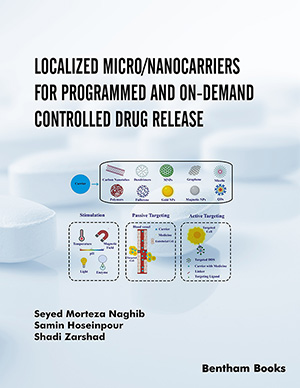Abstract
Exosomal nanoparticles are cell-derived nano-sized vesicles in the size range of 30-150nm formed by the inward infolding of the cell membrane. They are encased in a lipid bilayer membrane and contain various proteins and nucleic acids according to the characteristics of their parent cell. They are involved in intercellular communication. Their specific structural and inherent properties are helpful in therapeutics and as biomarkers in diagnostics. Since they are biomimetic, these small-sized nanoparticles pose many advantages if used as a drug carrier vehicle. In cancer, the exosomal nanoparticles have both stimulatory and inhibitory activity towards immune responses; hence, they are used in immunotherapy. They can also carry chemotherapeutic agents to the target site minimizing their targetability concerns. Chemoimmunotherapy (CIT) is a synergistic approach in which chemotherapy and immunotherapy are utilized to benefit each other. Exosomal nanoparticles (NPs) are essential in delivering CIT agents into tumor tissues. Most advanced studies in CIT take place in the stimulator of interferon genes (STING) signaling pathway, where the STING activation supported by chemotherapy-induced an increase in immune surveillance through the help of exosomal NPs. Dendritic cell(DC) derived exosomes, as well as Mesenchymal stem cells (MSC), are abundantly used in immunotherapy, and hence their support can be used in chemoimmunotherapy (CIT) for multifaceted benefits.
Keywords: Exosome, nanoparticles, cancer, chemotherapy, immunotherapy, chemoimmunotherapy, dendritic cells, mesenchymal stem cell.
[http://dx.doi.org/10.1016/j.trecan.2020.02.013] [PMID: 32460004]
[http://dx.doi.org/10.1016/S0021-9258(18)48095-7] [PMID: 3597417]
[http://dx.doi.org/10.1038/ncb1596] [PMID: 17486113]
[http://dx.doi.org/10.1007/s12033-021-00300-3] [PMID: 33492613]
[http://dx.doi.org/10.1016/j.ejpb.2020.07.026] [PMID: 32717385]
[http://dx.doi.org/10.1194/jlr.M003657] [PMID: 20424270]
[http://dx.doi.org/10.1093/nar/gkr828] [PMID: 21989406]
[http://dx.doi.org/10.3402/jev.v1i0.18374] [PMID: 24009883]
[http://dx.doi.org/10.1002/pmic.201200398] [PMID: 23401131]
[http://dx.doi.org/10.3390/ijms17020175] [PMID: 26861306]
[http://dx.doi.org/10.2147/IJN.S264498] [PMID: 33061359]
[http://dx.doi.org/10.1016/j.jconrel.2014.07.042] [PMID: 25084218]
[http://dx.doi.org/10.3390/ijms18061122] [PMID: 28538671]
[http://dx.doi.org/10.1016/j.xphs.2017.02.030] [PMID: 28283433]
[http://dx.doi.org/10.3390/pharmaceutics11120649]
[http://dx.doi.org/10.2147/IJN.S291956] [PMID: 33628021]
[http://dx.doi.org/10.1039/D0TB01499K] [PMID: 32697267]
[http://dx.doi.org/10.1007/978-1-62703-547-7_37] [PMID: 23913240]
[http://dx.doi.org/10.2174/1568009617666170710120311] [PMID: 28699500]
[http://dx.doi.org/10.1016/j.canlet.2020.05.036] [PMID: 32623071]
[http://dx.doi.org/10.1016/j.apsb.2021.01.001] [PMID: 34589397]
[http://dx.doi.org/10.1016/j.bioactmat.2021.08.029] [PMID: 34901546]
[http://dx.doi.org/10.3402/jev.v2i0.22097]
[http://dx.doi.org/10.1021/acs.molpharmaceut.9b00409] [PMID: 31241965]
[http://dx.doi.org/10.3389/fphar.2018.00735] [PMID: 30061829]
[http://dx.doi.org/10.1021/acs.molpharmaceut.8b00277] [PMID: 29771531]
[http://dx.doi.org/10.3390/cancers13020326] [PMID: 33477340]
[http://dx.doi.org/10.1155/2020/6691211] [PMID: 33343663]
[http://dx.doi.org/10.2147/IJN.S281890] [PMID: 33262592]
[http://dx.doi.org/10.1038/s41598-020-60212-1]
[http://dx.doi.org/10.1186/s12967-016-1056-9] [PMID: 27756426]
[http://dx.doi.org/10.1038/s41392-020-00261-0]
[http://dx.doi.org/10.1016/j.jconrel.2021.05.018] [PMID: 34015400]
[http://dx.doi.org/10.1186/s12951-021-00861-0] [PMID: 33865432]
[http://dx.doi.org/10.1038/s41586-018-0392-8]
[http://dx.doi.org/10.1007/s40820-020-00482-6] [PMID: 34138136]
[http://dx.doi.org/10.1136/jitc-2020-001698]
[http://dx.doi.org/10.1002/cncr.33269] [PMID: 33119177]
[http://dx.doi.org/10.1080/10717544.2021.1938757] [PMID: 34142930]
[PMID: 9516959]
[http://dx.doi.org/10.1038/s41467-019-11718-4] [PMID: 31444335]
[http://dx.doi.org/10.1016/j.biomaterials.2020.120542] [PMID: 33249316]
[http://dx.doi.org/10.1038/s41565-021-00931-2] [PMID: 34211166]























